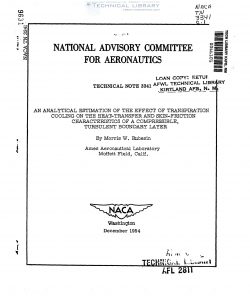naca-tn-3341
- Version
- 103 Downloads
- 3.08 MB File Size
- 1 File Count
- January 23, 2017 Create Date
- January 23, 2017 Last Updated
National Advisory Committee for Aeronautics, Technical Notes - An Analytical Estimation of the Effect of Transpiration Cooling on the Heat Transfer and Skin Friction Characteristics of a Compressible, Turbulent Boundary Layer

An analysis based on mixing-length theory is presented which
indicates that surface blowing associated with transpiration cooling
systems produces large reductions in both the heat-transfer and skin-
friction coefficients for a turbulent boundary layer on a flat plate.
The numerical results are restricted to the case of air blowing into
air. The effects of blowing are indicated to be similar for high-speed,
compressible flow to those for low-speed, incompressible flow.
The frictional heating of the outer surfaces of high-speed aircraft
has become a major problem in the design of these aircraft. Without
thermal protection and at equilibrium conditions, the surfaces of these
aircraft will begin reaching intolerable temperatures at Mach numbers
even as low as 2. The designer, therefore, must provide thermal
protection for his aircraft‘s skin._ This protection can be achieved in
several ways; for example, by altering the aircraft's shape to avoid
sharp or pointed frontal surfaces, by providing a cooling system for the
skin, and by providing a protective thermal insulating layer between
the hot air in the boundary layer and the skin. A transpiration cooling
system, one in which the coolant passes through small pores in the skin
and into the outside boundary layer, has the advantage of providing both
cooling of the skin and a protective insulating layer of coolant. It
appears that these advantages make a transpiration cooling system most
effective (ref. 1). It is noted that the advantage of evaporation can
also be incorporated into a transpiration cooling system.
Much of the available work dealing with transpiration cooling is
restricted to analyses dealing with the laminar boundary layer. The
literature is quite extensive and references 2 and 3 represent examples
of these analyses. Investigations which are more allied to the work
presented in this paper are represented by references A, 5, and 6.1
These analyses treat the case of the turbulent boundary layer by divid-
ing the boundary layer into two parts, a laminar sublayer and a fully
turbulent outer region. The end results of these analyses, in effect,
relate the coefficient of heat transfer under conditions of transpira-
tion with two parameters; namely, (1) the velocity at the interface of
the sublayer and outer turbulent portion and (2) a Reynolds number based
on the distance of this interface from the surface with properties
evaluated either at the wall or free-stream temperature. The rate of
transpiration acts as an independent variable in the latter relation.
| File | Action |
|---|---|
| naca-tn-3341 An Analytical Estimation of the Effect of Transpiration Cooling on the Heat Transfer and Skin Friction Characteristics of a.pdf | Download |

Comment On This Post